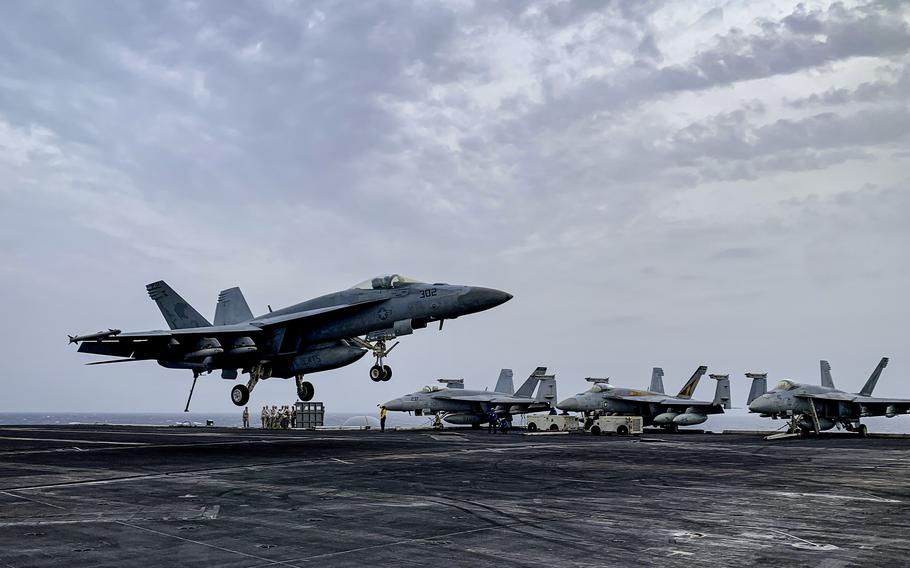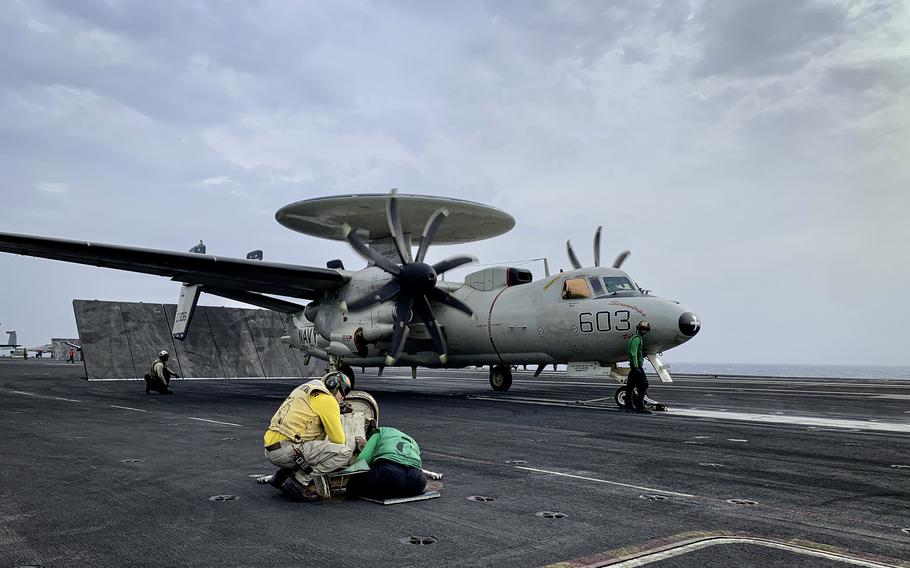
A F/A-18 Super Hornet lands on the flight deck of the aircraft carrier USS Dwight D. Eisenhower in the Red Sea on March 19, 2024. The carrier has launched about 100 flights daily, six-to-seven days a week since Dec. 31. (Alison Bath/Stars and Stripes)
ABOARD THE USS DWIGHT D. EISENHOWER — Iranian-backed Houthi militants in Yemen responsible for putting U.S. sailors under fire at levels comparable to World War II battles aren’t getting much rest these days.
That’s because the 7,000 sailors of the Dwight D. Eisenhower Carrier Strike Group are successfully frustrating the militant group’s efforts to terrorize ships in the Red Sea, said Rear Adm. Marc Miguez, commander of the group.
Miguez and others aboard Eisenhower acknowledged the Houthi fighters have been savvy in adapting their efforts with swarm drone attacks and upgraded ballistic missile capabilities. They also recognize Iran’s determination to continue arming them.
But near daily strikes made by F/A-18 Super Hornets and the group’s destroyer squadron against Houthi drones, missiles and other capabilities have eroded the group’s maneuverability, effectively reducing their activity, he said.
For example, the aircraft carrier USS Dwight D. Eisenhower went on a shipwide alert Wednesday morning, quickly launching two Super Hornets within four minutes of each other after learning the Houthis appeared to be preparing to use attack drones on unspecified targets.
An E-2 Hawkeye command and control aircraft and two refueling tankers soon followed.
U.S. Central Command subsequently announced a coalition aircraft had destroyed one aerial drone and that CENTCOM had destroyed one surface drone launched from Houthi-controlled areas of Yemen.
The action is among U.S. and coalition efforts that have allowed more than 2,000 ships, many under military escort, to come through the Red Sea safely since January, Miguez said.
He also acknowledged at least a 20% drop off in shipping through the vital waterway compared to recent years.
“My job is to keep the Houthis up at night and I routinely do that,” Miguez said. “We make sure we apply pressure all the time.”
Miguez added he sleeps well knowing the ship’s crew is protecting him and other sailors.
The Eisenhower and its escorts arrived in the Middle East on Nov. 4, ordered there by Defense Secretary Lloyd Austin as part of a U.S. effort to keep the Israel-Hamas war from broadening within the region.
About two weeks later, the Houthis began targeting ships in the Red Sea, putting the strike group in what the Navy deems an “active weapons engagement zone.”
As a result, the strike group, which includes the destroyers USS Gravely and USS Mason along with the cruiser USS Philippine Sea, ultimately saw the unprecedented use of anti-ship ballistic missiles in combat against a commercial ship on Dec. 30, the White House said in a statement Jan. 3.
Those two missiles were shot down by Gravely. The destroyer USS Laboon also responded. A day later, the same commercial vessel was attacked by four Houthi fast boats.

The flight deck crew prepares to launch an E-2 Hawkeye command and control plane off the deck of the aircraft carrier USS Dwight D. Eisenhower on March 19, 2024. (Alison Bath/Stars and Stripes)
Helicopters from the Eisenhower responded to the ship’s distress call, coming under fire from the boats. The helicopters returned fire, sinking three vessels and killing their crews. The fourth boat fled, the White House statement said.
It was a moment of reckoning for the 5,000 sailors aboard Eisenhower, said Capt. Chris Hill, commander of the aircraft carrier. Another 2,000 service members are assigned to other ships and units in the strike group.
“For us, witnessing that visually was somewhat of a wake-up call for the entire ship,” Hill said. “This is real and it’s going to get busy, and it’s been busy ever since.”
Since then, Eisenhower has launched about 100 Super Hornets, Hawkeyes, EA-18G Growlers and other aircraft day and night to help put the squeeze on the Houthi militants. Those flights typically take place over a span of 12 to 14 hours, six to seven days per week, said Capt. Marvin Scott, commander of Carrier Air Wing Three.
Some planes are on dynamic targeting missions used to identify Houthi movements that indicate the potential launch of drones or missiles. The goal is to eliminate them before they become an immediate threat, Scott said.
Other flights are for patrol, reconnaissance, defensive and other missions, he said.
It’s a grueling pace that has kept Eisenhower at sea for nearly five months without the usual port calls for sightseeing, eating a meal off ship or just getting a much-needed break from the job.
The pace isn’t typical. It’s also vastly different from the group’s original plans.
Sailors had prepared for deployment to the U.S. 6th Fleet area of operations, which would include port calls in Europe and along the Mediterranean. That vision changed quickly in the aftermath of Hamas’ Oct. 7 attack on Israel.
While a normal deployment could see a similar surge, sustaining it for months without giving sailors a break in port is remarkable, Scott said.
A sailor talked about the unrelenting tempo while having breakfast in a ship mess hall.
It would be easy to get mad about it but everyone aboard is going through the same thing, said the sailor, who added everyone aboard was committed to the mission.
Navy officials asked reporters aboard the ship not to name the sailors other than senior leaders, due to concerns that they could be targeted by terror groups.
The sailors also are bearing the stress of being in the crosshairs of the Houthis, who have focused attacks on U.S. destroyers as often as two times per week, said Capt. David Wroe, commodore of Destroyer Squadron 22.
The Houthis have said they will continue attacking ships connected to Israel until there is a cease-fire in Gaza. U.S. officials have pointed out the group has fired indiscriminately on military and civilian ships with no apparent Israeli connection.
The attacks can come in the form of a drone heading toward or operating in the vicinity of a ship or a missile launch.
For example, Houthi missiles targeted the Laboon at least three times since January, the latest a close-range ballistic missile attack on March 12. The missile didn’t hit the destroyer and no one was injured, CENTCOM said. The destroyer USS Carney also faced at least one Houthi missile attack.
The closest comparison of American sailors coming under fire for months at a time goes back to World War II, Wroe said.
Nothing in Wroe’s 25-year career as a surface warfare officer, which has included multiple deployments to the Middle East, compares to what the strike group is experiencing now, he said.
“This isn’t small scale stuff,” said Wroe, noting Houthi ballistic missiles were responsible for sinking one commercial ship, damaging others and killing at least three sailors on another merchant vessel.
Sailors “are under threat of getting attacked with minutes of notice, six out of seven days a week,” Wroe said. “They have seconds to respond.”
Despite that stress and hardship, sailors are determined to continue until the threat in the Red Sea is gone and ships can travel in safety.
“We have to be perfect,” said Capt. Colin Price, executive officer of the Eisenhower. “It’s a zero-fail mission.”